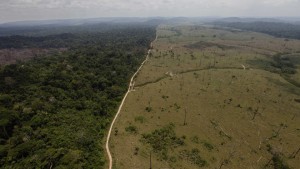An international team of 158 scientists found that depending on the degree to which deforestation comes under control in the next 35 years, between 36 and 57 percent of the 16,000 tree species in the tropical rainforest area would be considered threatened. A first-of-its-kind examination of the Amazon’s trees found that as many as half the species may be threatened with extinction or heading that way because of massive deforestation. Among the more than 5,000 tree species in deep trouble, the ones that produce Brazil nuts and mahogany.
Prof Carlos Peres from the University of East Anglia’s School of Environmental Sciences in Norwich is one of 158 researchers from 21 countries who worked on the study. He said there was a big gap in knowledge about all the plants and animals in the Amazon, from trees and ferns to bats and birds. “Our research estimates that more than half of all species may face extinction,” he said. “Fortunately protected areas and indigenous territories now cover over half of the Amazon basin, and likely contain sizeable populations of most threatened species.” He said parks and reserves which face “a barrage of threats from dam construction and mining to wildfires and droughts” will prevent extinction of threatened species only if they are properly managed. “In a sense this is a call for more effort into the ‘last chance saloon’ to discover this diversity before it goes inevitably extinct,” said Prof Peres. William Laurance from James Cook University in Australia, who also contributed to the study, added: “Either we stand up and protect these critical parks and indigenous reserves, or deforestation will erode them until we see large-scale extinctions.”
The range rests on whether cutting down the region’s forest continues at the rate of the late 20th and early 21st centuries or slows down to lesser levels proposed in 2006, study authors said. If deforestation continues at the same pace, nearly 8,700 tree types are in trouble, but the number of species at risk could be as low as 5,500 if nations are able to cut back as planned, said study co-author Nigel Pitman from the Field Museum in Chicago. “We’ve never had a good idea of how many species are threatened in the Amazon,” Pitman said Friday. “Now with this study, we have an estimate.” About 15 years ago, the Amazon was losing about 11.6 million square miles of forest a year, said Tim Killeen, a scientist from Agteca Amazonica in Bolivia. But that figure has dropped to about 3.8 million square miles a year, he said.
Killeen said the tree that produces Brazil nuts is seriously under threat, while “mahogany is commercially extinct throughout the Amazon.” He said that means there’s no more industry harvesting the wood, but some trees exist. Those losses would likely affect iconic tree species including Brazil nut, cacao, and açai palm, which play central roles in the regional economy. What’s more, Amazonian forests help trap a vast amount of carbon, which, if unleashed through deforestation, could exacerbate an already warming climate. “We want to make sure the Amazon keeps the carbon sink,” ter Steege says. “This is important.”
For more information please visit: www.fieldmuseum.org


Comments are closed.